





It is with great excitement and pride that we welcome you to the newly reimagined Triangle Family! While our mission remains deeply rooted in celebrating family, community and excellence, our fresh look and elevated editorial vision bring even more inspiration, insight and impact into your homes.
With this frst issue under our new direction, we embrace the spirit of Lifestyle to Legacy—a promise to guide families through every chapter of life. Whether you’re a young parent creating core memories or an empty nester exploring new horizons, we’re here to accompany you with expert advice, stylish living inspiration and stories that refect the vibrancy of the Triangle region.
Fittingly, our May/June issue is themed Travel & Adventure, celebrating the journeys that bring us closer—to the world around us and to one another. In these pages, you’ll fnd inspiration for unforgettable family getaways, including can’t-miss North Carolina destinations that every child should experience before they’re grown. We also explore the joys and nuances of multigenerational travel, with practical tips for making it meaningful and stress-free, no matter your crew.
We’re especially honored to introduce you to the Singletary family of Raleigh, our May/June cover stars, whose poignant story illustrates the strength of family bonds. And with summer just ahead, we’re also prioritizing safety by spotlighting tips and resources to keep your family secure while enjoying North Carolina’s beloved waters. The state’s professional and amateur sports attractions are sure to keep you and your family entertained, not just this summer but throughout the year.
In addition to our exciting editorial refresh, we’re proud to announce the launch of the Triangle Impact Awards, our annual reader-powered celebration of the businesses and professionals making a lasting difference in our community. More than just a gala, it’s a tribute to the excellence and innovation that fuel this region we all love.
Thank you for joining us in this bold new chapter. Triangle Family is more than a publication—it’s a celebration of family, a chronicle of legacy and a refection of the vibrant lives that make our region so extraordinary. We’re honored to be on this journey with you.
Warmly,
Kent Braswell, Publisher publisher@trianglefamilymag.com


PUBLISHER
Kent Braswell
EDITOR
Janice Lewine
SENIOR GRAPHIC DESIGNER
Fran Sherman
GRAPHIC DESIGNER
James Jarnot
SECTION EDITOR
Kurt Dusterberg
Health, Wellness and Youth Sports
COPY EDITOR
Mario Boucher
CONTRIBUTORS
Mandy Howard
Katherine Kopp
Cary Pediatric Dentistry
SOCIAL MEDIA AND COMMUNITY ENGAGEMENT MANAGER
Stacy Rank
SALES DIRECTOR
Sherry Braswell
ACCOUNT EXECUTIVE
Stefanie McClary
DISTRIBUTION
Joe Lizana
Berry Media Group DistribuTech.net
Triangle Family magazine is published six times annually. Any reproduction in part or in whole of any part of this publication is prohibited without the express written consent of the publisher. Copyright 2025. All rights reserved.
Triangle Family magazine is not responsible for unsolicited manuscripts, photography or art. Unsolicited material is welcome and is considered intended for publication. Such material becomes the property of the magazine and is subject to editing. Triangle Family magazine will not knowingly accept any real estate advertising in violation of U.S. equal opportunity law.
SUBSCRIPTIONS
6 print issues per year
Available online at trianglefamilymag.com
150 Preston Executive Drive Suite 201 Cary, NC 27513
919.617.6889




Dear Readers,
As we embark on this exciting new era for Triangle Family, it feels only fitting to introduce you to the family behind the vision—the Braswells.
Kent and Sherry Braswell have called the Triangle home for decades. Married in 1999, they have built a life centered around family, community and service. A dynamic duo, Kent and Sherry serve as publisher and sales director, respectively, leading Triangle Family with passion and purpose. Their journey together has been one marked by love, laughter and a commitment to making a lasting impact both personally and professionally.
Their daughters, Kaeli and Olivia, have each carved inspiring paths of their own. Kaeli, born in 2002, is a proud graduate of Furman University, where she excelled both academically and athletically as a member of the varsity volleyball team. Awarded a prestigious four-year ROTC scholarship, Kaeli now serves our nation as a Second Lieutenant and Platoon Leader in the United States Army.
Olivia, born in 2006, is forging her own legacy as a Plebe at the United States Military Academy at West Point. Following in her sister’s athletic footsteps, Olivia also competes on the varsity volleyball team while preparing for a life of leadership and service.
Now navigating the joys of empty nesting, Kent and Sherry reside in Cary, where they share their home with River, their spirited eight-month-old puppy, and Willow, the beloved cat left in their care by Olivia. Their days are filled with travel to visit their daughters, long walks with River and hosting family and friends, all while continuing to foster the strong bonds that have always been at the heart of their story.
The Braswell family embodies the spirit of Triangle Family: celebrating life’s milestones, embracing adventure and building a legacy rooted in love and community. They are honored to share their journey with you, and even more excited to continue building connections across the families of the Triangle.
Warmly, The Triangle Family Team

BY ELAINE JOLLEY, FINANCIAL ADVISOR, CDFA VESTA WEALTH ADVISORS
In today’s economy, saving money isn’t just a good habit—it’s a vital survival skill. With rising grocery costs, high interest rates and the increasing impact of tariffs on everyday goods, many families are feeling the pinch. While some factors are beyond our control, how we respond financially can make a difference.
Smart money habits aren’t about how much you earn; they’re about what you do and how you think. The most effective strategies are often simple, passed down through generations and strengthened by today’s tools.
Here’s how families can blend timeless wisdom with modern resources to cultivate smart money habits across generations.
When my husband and I married, my dad shared a powerful piece of advice: “You’re used to living on one income. Don’t change that just because you can.” We took this to heart, saving one income while living on the other. This choice brought us flexibility, taught us discipline and gave us peace, especially during my time at home with our kids.
Those early decisions sparked important conversations about money—a skill I encourage all couples to practice regularly. Setting up regular “money dates” allows couples to set goals, ask questions and stay aligned. It’s a fun way to make finances a team effort.
Not everyone can live on one income, but you can start by paying yourself first. Saving consistently doesn’t mean you have to set aside huge amounts. One couple I worked with felt overwhelmed by the idea of saving for retirement while raising three young kids. We reframed it: treat your savings like your mortgage or utility bill. Pay yourself first, even if it’s just $100 a month. When savings come out first, you’re less likely to overspend or forget about those

subscription services that add up. And as your income grows, increase that amount—it’s like giving your savings a raise! Over time, those small contributions can build momentum and confidence.
If we want the next generation to make smart money choices, we need to start early. Talk to your kids about what things cost, such as groceries, gas and school supplies, and involve them in everyday decisions. Even simple conversations, like comparing the price of brand-name cereal to the store brand, can spark awareness.
Give their allowance a purpose using the three-bucket method: save, spend and share. This simple strategy teaches balance and values, and opens the door to discussions about generosity. Whether it’s donating to your church, an animal shelter or buying food for a local pantry, supporting a cause your kids care about—even in small amounts—can have a big impact.

BY KURT DUSTERBERG
A
TO WANDER? THERE’S PLENTY TO DO AT RALEIGH PARKS
Raleigh is known for its outdoor attractions, including more than 200 parks. Families can take advantage of amenities such as playgrounds, fields, pools and dog parks. Many have community centers with classes as well. Here’s what else you can find at Raleigh parks.
• Athletic sites
• Greenways and trails
• Athletic fields and courts
• Lakes
• Pollinator gardens
If you’re ready to check out a new park with the family, visit raleighnc.gov/parksand-recreation.

A FAMILY BEACH TRIP? BRING YOUR GOLF CLUBS … AND A BOWLING BALL
A trip to the coast brings out the beach bum in all of us, but it’s easy to mix in a little active family fun. (And for parents, it’s never a bad idea to work off those beachdrink calories.) A good game of beach volleyball is a good place to start, but here are other ways to keep active while enjoying the sand and surf, courtesy of activeforlife.com.
Mini golf. Buy a set of plastic golf clubs and balls, and play the game in the ultimate sand trap. Set up targets or dig holes to finish your putts. Adults might need to get on their knees to swing the mini club, which only adds to the fun.
Beach bowling. Again, start with a mini set of plastic bowling balls and pins. Make a nice smooth lane—even gutters—and then see who can master the challenge of rolling a sandy strike.
Staying active is an important part of overall health. According to the Centers for Disease Control and Prevention, adults need a mix of aerobic and muscle-strengthening activities each week—and the activity needs to be at a moderate or vigorous intensity. Aerobic physical activity (or “cardio”) can be anything that makes you breathe harder or your heart beat faster.

Here are some examples of moderate aerobic activity.
• Walking fast
• Doing water aerobics
• Riding a bike on level ground or with few hills
• Pushing a lawn mower
If you can take on more vigorous activities, try these options:
• Jogging or running
• Swimming laps
• Riding a bike fast or on hills
• Playing singles tennis or basketball
BY JANICE LEWINE

Marbles Kids Museum in Raleigh recently launched the public phase of its first-ever Capital Campaign, “Bigger Play, Brighter Futures,” funding the largest expansion in the organization’s history.
The campaign will support the completion of a two-story addition featuring over 3,000 square feet of publicfacing space. The addition will include “Futuropolis,” an exhibit highlighting in-demand careers and industries in North Carolina; Think Tank, a classroom for educational programming, field trips and camps; and Marbles Skyway, a rooftop playscape featuring a kid-size racetrack for active play.
“Bigger Play, Brighter Futures” will also fund the beautification of the museum’s Blount Street exterior facade, enhance guest amenities throughout the building and support the Marbles Impact Fund, an investment fund to bolster the organization’s future sustainability and accessibility. Construction for the expansion is set to begin in late 2025. The museum will be operational during this time. Learn more at marbleskidsmuseum.org/biggerplay.
C-SPAN, the private nonprofit public affairs media organization, recently announced that 16 students in Chapel Hill and Raleigh are winners in C-SPAN’s 21st annual StudentCam video documentary competition. The project-based learning experience gives students the opportunity to explore matters of personal, local or national importance.
Benjamin Lovelady, a student at R.D. and Euzelle Smith Middle School in Chapel Hill, was a second-prize winner and received $1,500 for his video, “Moving Forward—The Future of American Transportation.” Honorable mention prizes of $250 were awarded to the following students: Jason Sliwowski and Kingsley Chen of R.D. and Euzelle Smith Middle School; Laila Kwong and Elissa Huettel of East Chapel Hill High School; and Brighid Lee, Amber Tirado, Lalan Brewer, Natalie Simora, Victoria Adams, Erin Haugland, Rachel Winter, Avery Herrera, Emilia Boes, Ella Rigot and Carson Margulies of Millbrook Magnet High School in Raleigh.
The StudentCam competition has awarded over $1.6 million in prizes since 2004. All 150 documentaries from the 2025 competition can be viewed at studentcam.org.

On April 16, TMSA Triangle High School unveiled its state-of-the-art, 120,000-square-foot campus at 3570 Amberlight Road in Apex. With a capacity for 1,200 students, the cutting-edge facility features more than 70 classrooms and specialized labs—including science, media, digital arts and finance labs—to empower students with 21st-century skills. The campus also boasts a cafeteria, an indoor gymnasium, a full-size football field, and outdoor basketball and tennis courts. North Carolina Superintendent of Public Instruction Mo Green and Apex Mayor Jacques Gilbert attended the ribbon-cutting ceremony.
TMSA is North Carolina’s growing network of nonprofit public charter schools focusing on STEAM (science, technology, engineering, the arts, and mathematics). TMSA Triangle originally opened in 2012 in Raleigh and later moved to a K–12 campus in Cary. Due to increasing demand, TMSA decided to open a dedicated high school campus to expand its capacity and serve more students. In its Cary K-8 and Apex High School campuses, TMSA Triangle currently serves more than 2,000 students. TMSA Triangle was ranked the best K–12 charter school in the state, according to the 2023-2024 North Carolina School Performance Grades. Learn more at tmsatriangle.org.
BY KURT DUSTERBERG

More than 175 kids and families attended The Alice Aycock Poe Center for Health Education’s Terrific Teeth Day event on February 1. The activity provides free dental screenings from the Colgate Dental Bus.
Participants spent the morning at the facility engaging in dental health-themed activities. Kids enjoyed balloon art, face painting, story time, Dr. Robert Orander’s dental magic show, a meet-and-greet with Emerald Pine the Tooth Fairy and a chance to make tooth fairy pillows.
During the event, the Poe Center emphasized the importance of brushing teeth twice a day for two minutes, visiting a dentist twice a year and making proper nutritional choices. The nonprofit offers fun dental health programs designed for children from preschool age through third grade. For more information, visit poehealth.org.

Most of us have fallen into the trap of eating when we’re not hungry. Children are just as prone to relying on food for reasons other than satisfying their hunger, according to healthychildren.org.
It is common for kids to eat when feeling anxious over an upcoming test or in reaction to the way they are treated at school. But excess eating can be caused by a range of emotions, including boredom, insecurity, anger and stress. It’s a good idea to keep an eye on eating habits, particularly for children who are eating more than three meals and one snack each day.
Where childhood obesity is concerned, moms and dads can help. When a reward is appropriate, choose something other than a treat, such as purchasing clothes or a toy. And don’t overlook the importance of verbal praise, which can boost self-esteem.
WakeMed and UNC Health earned the top ratings in U.S. News & World Report’s 2025 list of Best Hospitals for Maternity Care. WakeMed Cary Hospital, WakeMed North Hospital, WakeMed Raleigh Campus, UNC Hospitals (Chapel Hill) and UNC Health Rex (Raleigh) all earned High Performing designations measured by factors such as newborn complications, cesarean-section rates, birthing-friendly practices and other measures. U.S. News & World Report evaluated 817 hospitals that provide high-quality labor and delivery services for uncomplicated pregnancies for this year’s list.











Outer Banks, Oak Island and Bald Head Island
From Currituck to Bald Head Island, eight iconic lighthouses dating back to the 1800s that once led seafarers away from treacherous shorelines now delight thousands of visitors who come to admire their majesty. Four guiding lights—Currituck Beach, Bodie Island, Oak Island and Old Baldy—are open seasonally and beckon guests to climb their spiraling staircases for sweeping views of the surrounding coastline. Two others, Cape Hatteras and Cape Lookout, are currently closed for climbing due to ongoing restoration efforts. Though not ascendable, Ocracoke Lighthouse yields its own charm as the oldest continuously operating lighthouse in the state and the second oldest in the nation. Much shorter than its coastal cousins and resembling a lightkeeper’s cottage, the Roanoke Marshes Lighthouse is open to visitors in the spring, summer and fall, and features exhibits that highlight Roanoke Island’s unique maritime history. visitnc.com




Corolla, Shackleford Banks, Beaufort and Ocracoke Island
Over 400 years ago, explorers brought rugged Spanish mustangs to the New World, where they roamed freely along the entire length of the state’s coastal barrier island chain. Having long survived this harsh environment, the horses’ descendants are now protected by conservation groups. These wild equines roam 7,500 acres of safeguarded land in Corolla; along the 9-mile barrier island of Shackleford Banks; the main area of Rachel Carson Reserve in Beaufort; and in a 100-acre fenced pasture off N.C. Highway 12 on Ocracoke Island. Visit ncwildhorses.com for tips on viewing these magnificent creatures and to learn about the distinct characteristics of each group. ncwildhorses.com


Wilmington
Moored on a dredged slip on the Cape Fear River, the decommissioned battleship USS North Carolina took part in every major naval offensive in the Pacific theater of operations during World War II, earning 15 battle stars. This authentically restored National Historic Landmark serves as a memorial to the 11,000+ North Carolinians who made the ultimate sacrifice. Explore the ship’s nine levels at your own pace, climb inside gun turrets, marvel at early naval technology and examine the combat information center. See the tight quarters where the crew worked, ate, bathed and slept. Through oral histories and mementos, learn about the men who protected our nation aboard the celebrated warship. battleshipnc.com






George Vanderbilt’s French Renaissance-style chateau in Asheville is as impressive today as it was more than a century ago. Biltmore House boasts 175,000 square feet, three floors, 250 rooms, an indoor pool and bowling alley. Comprising 8,000 acres, Biltmore Estate beckons guests to enjoy carriage rides, horseback riding and garden strolls, just as the Vanderbilts did. Antler Hill Village offers farmyard visits, live demonstrations by blacksmiths, woodworkers and other craftspeople, as well as turn-of-the-century games and hands-on crafts for the kids.
Engaging, temporary exhibits enlighten visitors, including “Tutankhamun: His Tomb and His Treasures,” running through January 4, 2026. This unforgettable cultural experience explores the special connection the Vanderbilt family had with Howard Carter, who discovered King Tut’s tomb in Egypt’s Valley of the Kings in 1922, and culminates with a three-dimensional recreation of the excavation site, the legendary tomb and expertly crafted replicas of its treasures exactly as they were at the moment of discovery. biltmore.com

Kure Beach
Fort Fisher kept North Carolina’s port of Wilmington open to blockade runners supplying necessary goods to Confederate armies inland during the Civil War. When Fort Fisher fell after a massive amphibious assault by Union forces in 1865, its defeat helped seal the fate of the Confederacy. Approximately 10% of the fort still stands.
The newly renovated visitor center, which opened last fall and represents a $25.5 million investment, features the “Through Their Eyes” exhibit. This immersive journey through the region’s history, from pre-Colonial times to the fort’s role in WWII, highlights the personal stories of those who lived through these significant moments. The site’s earthworks have been partially restored, and guests can explore reconstructed mounds, trenches and fortifications, as well as a central sally port and an ammunition magazine with a working tunnel system. A new underwater archaeology lab focuses on preserving and researching the region’s maritime history, including shipwrecks like the Condor and Civil War-era artifacts. historicsites.nc.gov/all-sites/fort-fisher




This Western-themed, 200-acre amusement park has been delighting visitors in the High Country since 1957. Open seasonally from April to October, Tweetsie Railroad operates 17 classic amusement rides, including a carousel, Ferris Wheel, Tilt-A-Whirl and several just for tykes. The pride of the park is its two historic narrowgauge steam locomotives, No. 12 “Tweetsie” and No. 190 “Yukon Queen,” that take passengers on a 3-mile scenic ride around the park, crossing a trestle and circling a mountain—and where kids can let their imaginations run wild becoming cowboys, sheriffs and train engineers. Live entertainment, the Deer Park Zoo, gold panning and gem mining round out the fun. Don’t miss Tweetsie’s special events—Day Out With Thomas, Ghost Train and Tweetsie Christmas—that are sure to create lasting memories. tweetsie.com


The North Carolina Aquariums are dedicated to animals in their care and in the wild while recognizing the challenges animals face locally and globally. The aquariums at Fort Fisher in Kure Beach, Pine Knoll Shores, and Manteo on Roanoke Island deliver an up-close look at sharks, eels, alligators, otters, sea turtles and other aquatic wildlife through interactive exhibits, live programs and more. Jennette’s Pier in Nags Head boasts three unique exhibits in the pier house that feature eels, a variety of fish species and the ocean’s microorganisms, as well as fishing opportunities. Advance tickets are required for all the aquariums except Jennette’s Pier. ncaquariums.com
What happened to the 117 English men, women and children who established a colony on Roanoke Island in 1587? When leader John White returned from England with supplies three years later, he found no trace of the settlers and only the letters “CRO” carved into a tree. The fate of these pioneers has fascinated researchers ever since, though many have proposed theories, including disease, starvation, conflict with Native Americans or even assimilation into a local tribe. For 87 years, the Roanoke Island Historical Association has performed the intriguing story of “The Lost Colony” each summer at the outdoor Waterside Theatre along the shore of the Roanoke Sound, which offers one of the best views of the sunset on the Outer Banks. Take advantage of the backstage tour and Native American cultural presentation before the show. thelostcolony.org

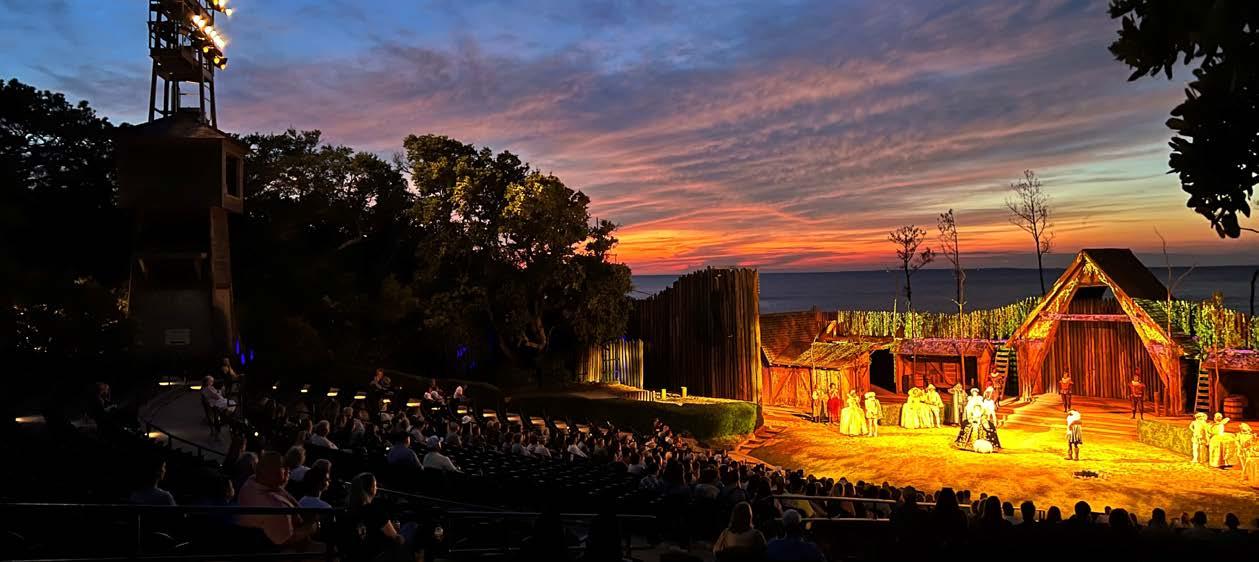


The notorious pirate Blackbeard wasn’t the only one who found the island of Ocracoke idyllic. From the late 1600s to the mid-1700s, countless sea thieves lay in wait here, poised to attack ships that ran aground in the shallow sandbars known as the Diamond Shoals. Follow in their footsteps by taking the two-and-a-half-hour ferry ride from Swan Quarter or Cedar Island to Ocracoke, where you can view the small channel of water known as Teach’s Hole—and where Blackbeard reportedly moored his flagship Queen Anne’s Revenge and met his demise. Blackbeard’s Pirate Jamboree held each autumn is a two-day, family-friendly festival that celebrates his legacy on this Outer Banks destination, which tantalizes visitors with uncrowded beaches, local cuisine and stunning sunset views. visitocracokenc.com and facebook.com/blackbeardspiratejamboree

Known as “America’s Favorite Drive,” the Blue Ridge Parkway beckons visitors to explore its rugged mountains and pastoral landscapes, which protect a large diversity of plants and animals. The National Park Service maintains 272 scenic overlooks throughout the 469-mile parkway that stretches into Virginia. The slow-paced drive is unlike any other, revealing stunning long-range vistas and close-up views of the Appalachian Highlands. All four seasons flaunt their own beauty, making any month ideal to visit. Stretch your legs on the parkway’s 120 hiking trails that range from easy to strenuous and be rewarded with the sights and sounds of roaring waterfalls, forests brimming with wildlife and fields abloom in wildflowers. blueridgeparkway.org


Cherokee
The Cherokee people have greatly enriched the culture of Western North Carolina, leaving a remarkable legacy of artifacts, art, agricultural methods and the preservation of their language. Their story reflects a people who remain strong, even in the face of great strife. “Unto These Hills” is a live, two-hour production detailing their triumphs and tragedies throughout history. Performances take place nightly, May–August, at the outdoor Cherokee Mountainside Theatre (closed Sundays). Take a guided tour to the 1700s at the nearby Oconaluftee Indian Village to find Cherokee dwellings, work areas and sacred ritual sites. Watch Cherokee villagers hull canoes, weave baskets and even prepare for battle. The Museum of the Cherokee People exhibits art, archival material and objects of ancestral patrimony. visitcherokeenc.com


Bryson City
This laid-back mountain town lives up to its motto, “Uncrowded, Unhurried, Unspoiled, Uncommon,” while offering fresh mountain air and a bevy of charming shops and eateries. Adventure activities range from horseback riding and trail walking to zip lining and Jeep tours. Whitewater rafting on the Nantahala River is a popular pursuit, and local outfitters offer a variety of trips for families and paddlers of every skill level.
Climb aboard the Great Smoky Mountain Railroad departing Bryson City for a four-and-a-half-hour, roundtrip train ride that carries passengers to the breathtaking Nantahala Gorge, the charming town of Dillsboro and places you can’t get to by car. Ride this excursion via steam or diesel locomotive power and soak in the beauty of the Great Smoky Mountains. explorebrysoncity.com and gsmr.com



“We have gone to Disney World together a number of times,” she says. “We have also gone to the Cayman Islands, which has become an annual trip. We stay in separate condos and cook and eat some meals together. What works well for our family group is to do some activities together but not all.”
Dominique Harkness of Durham has traveled frequently with her two children, ages 3 and 10, her mother and her brother. Last year, the family enjoyed a trip to New Orleans. Often thought of as an adult destination, Harkness says her kids “loved New Orleans!”
Their favorite activity was a steamboat tour on the Mississippi River. “We had lunch on the boat and there was a jazz band playing,” she says. “It was an amazing experience for all generations.”
Other favorite activities for her family included checking out Canal Street’s shops, walking around the Garden District and exploring some of New Orleans’ famed cuisine—mostly for breakfast and lunch, which are more affordable.
Harkness and her family tend to book stays with one chain of hotels, accumulating points that can result in upgrades or other benefits. “We always book a suite or adjoining rooms that include a microwave and a mini refrigerator,” she says. “That helps us keep our food costs down.”
While the benefits of multigenerational travel can include greater family bonding and practical benefits
such as sharing costs, the experience can also present challenges.
“The cons can be that there may be different ‘speeds’ of travel for everyone,” says Parker, “and different interests that must be considered. Compromise is key.”
What has worked well for her family is “setting expectations ahead of time” and factoring in some time apart in the planning process.
“I’m a big believer in planning ahead and communicating as much as possible before the trip,” she says. “For example, if our family was contemplating travel to Disney World with my parents, I would say ahead of time, ‘We will be up by 8 a.m., have breakfast by 8:30, and go on to the park after that. Why don’t you plan to meet us there at 11 after you’ve had time to sleep in and have a leisurely breakfast?’
“If we are traveling with my parents and perhaps one of my sibling’s families too, we usually plan a halfday or day apart, then we come together later to share experiences.”
Parker also suggests giving older kids a role in the travel planning. “Everyone should get to choose one thing they really want to do at their travel destination, so everyone has buy-in on the trip,” she says. “And most importantly, once you’ve reached your destination, you’ve got to have grace and a sense of humor when traveling with grandparents, parents and kids. That will help assure that your trip is a success.” tf
Alice Parker* (name changed for privacy reasons)


BY JANICE LEWINE I PHOTOS BY JENN M c KINNEY PHOTOGRAPHY
The Singletary family of Raleigh, who grace the cover of this issue, embody the love, resilience and togetherness that form the heartbeat of strong families. Spanning three generations, their story is a beautiful tapestry woven with joy, loss, faith and an enduring commitment to one another. Like many families, they’ve faced seasons of sorrow and uncertainty—but through it all, their deep faith and tightly knit bond have carried them.
Macon and Monica Singletary began their life together in 1993 with a shared dream of building a home filled with love, laughter and purpose. Macon, a skilled periodontist who owns a thriving dental practice in North Raleigh, and Monica, a devoted mother and active community member, welcomed their first children—Savannah, Stephanie and Mitchell— with wide-eyed joy and gratitude. They also embraced Mary Leah and Marla, Macon’s children from a previous marriage, as a full and cherished part of their growing family.
In 1997, they were preparing to welcome another baby girl, Laura Anne. Before she was even born, doctors discovered she had a heart defect and Down syndrome. While the diagnosis of Down syndrome didn’t shake them, the condition of her heart brought a wave of fear and prayer.
Determined to give Laura Anne the best chance at life, the Singletarys took her to UNC Hospitals for surgery. At just three and a half months old, their baby girl underwent a complex procedure. The surgery itself was a success—but heartbreak followed. While recovering in the hospital, Laura Anne developed sepsis, a life-threatening infection. Despite every effort, she passed away a month and a half later.
“We miss her to this day,” Monica says softly. “But in the midst of our grief, we were overwhelmed by the love and support from family, friends and our church community. We truly felt God’s arms around us during that time.”
Although the loss was devastating, the idea of one day opening their home to another child—especially one with special needs—took root in their hearts. A year later, they contacted Amazing Grace Adoptions in Raleigh to explore adopting a child with disabilities. However, the financial



strain of a private adoption, alongside college tuition expenses, made the decision feel out of reach. With heavy hearts, they put the idea aside.
But sometimes, grace finds its way back.
About a year later, Monica received an unexpected phone call from Amazing Grace Adoptions. A baby girl had been born at WakeMed with Down syndrome. Her parents—an international couple from Senegal and France— were overwhelmed by the diagnosis and unable to care for her. The Singletarys were immediately drawn to the little girl’s story. “We asked about her heart,” Monica recalls. “And when they told us it was healthy, we just felt peace. We knew she was meant to be ours.”
With the help of a grant, the adoption fees were waived, and within two weeks Macon and Monica walked into the hospital and brought their daughter Sophia home. A new chapter began.
Today, Sophia is 24 years old and a joyful light in the Singletary home. “She’s a big part of the family and is so much fun,” Monica says, her voice full of pride. “She still lives at home with us and attends an amazing day program in Raleigh called Abound.”
Sophia graduated from Millbrook High School, where she was a beloved member of the cheerleading team. “They were so good to the special needs kids over there,” Monica adds. “It was such a gift.”
The love that binds the Singletary family is visible in every interaction. Their children are now grown, and the family continues to expand with grandchildren and new stories. Savannah and her husband recently welcomed a daughter, adding more joy to family gatherings. Stephanie and her husband are raising their daughter and are expecting another baby later this year. Mitchell is pursuing his law degree at Campbell University and enjoys life with his

girlfriend Amanda. Marla lives nearby in Raleigh, while Mary Leah now lives in Alabama with her husband and their four children—adding another beautiful branch to the family tree.
Though life has brought them through valleys, the Singletarys have never walked alone. Their unwavering faith and commitment to one another have been a refuge in every storm.
Monica reflects on their journey with humility and gratitude. “We don’t have a perfect family, but we
love deeply and try to show up for each other in all seasons. That’s what matters.”
Their home is filled with the kinds of things that make life sweet— laughter during shared meals, fun with grandchildren, and deep conversations between adult children and parents who have become friends. The Singletarys’ story reminds us that family isn’t just about biology. It’s about love, second chances and showing up when it counts. tf



Triangle sports fans have plenty to root for, from amateur to professional events
BY KURT DUSTERBERG
Regardless of the season, Triangle families are known for staying busy with sports. Sometimes that means following the kids to rec fields or travel tournaments. Other times, parents are on the move, staying active with golf, tennis and pickleball.
But when it’s time to take a break from competition, there are plenty of opportunities for families to be spectators at all levels of competitive sports. Raleigh is home to the major leagues, including the National Hockey League’s Carolina Hurricanes, minor league sports, major college athletics, and other competitions and attractions worth a visit.
Attending major league sporting events—such as the NHL’s Hurricanes or the NFL’s Carolina Panthers in Charlotte—can cost several hundred dollars for a family when you factor in tickets, concessions and parking. Keep in mind, however, that you’re watching the very best athletes in the world. By comparison, minor league sports are often ideal for families looking for a fun afternoon or evening out.
Tickets are often less than $20, all seats are near the action and most minor league teams market directly to families with in-game entertainment. Collegiate sports, particularly at the Division I level, also showcase some of the best athletes in the world—and not just in football and basketball. The University of North Carolina–Chapel Hill has won 23 national championships in women’s soccer and 11 in field hockey. North Carolina State University's men’s swimming and diving teams have won nine of the past 10 ACC Championships. Not only does that make for an impressive spectator experience, it can leave an impression on a young athlete with big dreams.
And don’t forget high school sports. If you have a child on a varsity team, you already know that high school competitions can be thrilling. If not, consider going to a game where your neighbor or a friend’s child is playing. You will gain an appreciation for the talent of today’s young players, and you might build some personal connections. Athletes appreciate the support.
1400 Edwards Mill Road, Raleigh nhl.com/hurricanes
The Carolina Hurricanes are the crown jewel of the Triangle sports scene. The team has become one of the NHL’s true success stories in its 28-year history, including a Stanley Cup championship in 2006. The captain-turned-coach of the Cupwinning team, Rod Brind’Amour, has taken the team to the playoffs in each of the past seven seasons, securing Carolina’s reputation as one of the elite franchises in the league.
The regular season features 41 home games at the Lenovo Center in Raleigh from October–April. The playoffs feature four rounds of best-of-7 action that can last until June.
èFUN FACT: Hurricanes fans, known as “Caniacs,” are widely known in hockey circles for introducing tailgating to the sport.

409 Blackwell Street, Durham milb.com/durham
The Durham Bulls have long been a staple of Triangle summers, offering the highest level of minor league baseball. The Bulls and their opponents play at the Triple-A level, one step below Major League Baseball. For the players, that means they’re one phone call away from playing for their parent club, the Tampa Bay Rays.
The schedule runs from late-March through mid-September, with Durham Bulls Athletic Park hosting 75 home games. The Bulls typically alternate weeks playing at home and on the road, with six-game homestands that run Tuesday-Sunday.
èFUN FACT: Baseball Hall of Famer Joe Morgan, the National League MVP in 1975 and 1976 playing for the Cincinnati Reds, hit .332 in 95 games for the 1963 Durham Bulls before making his major league debut the same season.
1501 N.C. Highway 39, Zebulon milb.com/carolina-mudcats
The Carolina Mudcats are a Single-A affiliate of the Milwaukee Brewers, so the players are still a few steps away from the major leagues. The team has played at Five County Stadium in Zebulon since 1991, but this will be the final season for the franchise. In 2026, the team will head 30 minutes east to become the Wilson Warbirds.
èFUN FACT: Future Hall of Famer Miguel Cabrera played most of the 2003 season for the Mudcats before jumping to the major leagues that season.
goheels.com, gopack.com, goduke.com, gocamels.com, nccueaglepride.com
Five Triangle-area universities compete in Division I athletics, the highest division in college sports. UNC–Chapel Hill, North Carolina State University and
Duke University are rivals in the Atlantic Coast Conference, while Campbell University plays in the Coastal Athletic Association and North Carolina Central University competes in the Mid-Eastern Athletic Conference. Keep in mind, there is a lot more to watch than football and basketball. Other sports like tennis, softball and wrestling all welcome spectators.
In addition to the top-level programs, St. Augustine’s University, Shaw University and Barton College play at the Division II level. William Peace University and Meredith College play Division III, where there are no athletic scholarships.
èFUN FACT: Most of the area Division I programs have at least 20 men’s and women’s sports teams.

101 Soccer Park Drive, Cary northcarolinafc.com and nccourage.com
North Carolina FC plays professional mens’ soccer in the USL Championship, the second tier of the United States league system. The season runs from March through October with games played on Fridays, Saturdays and Sundays.
The North Carolina Courage play in the National Women’s Soccer League, the highest level of the U.S. soccer league system. The team won the league championship in 2018 and 2019.
Owned by Raleigh businessman Steve Malik, both teams play at the 10,000-seat First Horizon Stadium at WakeMed Soccer Park in Cary. In addition, the teams are partnered with North Carolina FC Youth, creating the largest youth-to-pro program in the country.
èFUN FACT: NCFC began as the Carolina RailHawks in April 2007. The Courage started operating in April 2017 after the relocation of the Western New York Flash franchise.
2109 Simpkins Road, Raleigh wcspeedway.com
Wake County Speedway maintains one of North Carolina's most beloved traditions: auto racing. On Friday nights from March through September, close to 1,500 fans cheer on drivers in late model, mini stock, legends and other classes.
The NASCAR-sanctioned, quarter-mile asphalt track is a bit of a throwback in the local sports scene, dating to 1962. Local semipro drivers are racing for more than pride, with nightly cash purses in the various classes.
èFUN FACT: The speedway was a dirt track for 24 years. It was paved prior to the start of the 1987 season.

1921 West Gate City Blvd., Greensboro gsocomplex.com/venues/detail/acc-hall-ofchampions
The Atlantic Coast Conference is steeped in college sports tradition, and the ACC Hall of Champions captures all of its history at the Greensboro Coliseum Complex’s Special Events Center.
Discover individual exhibits for each of the member schools, including displays of memorabilia, trophies and photos that celebrate the players, coaches and fans. For added fun, guests can take photos with life-size mascots from each school.
èFUN FACT: The ACC accepted Southern Methodist University, Stanford University and the University of California Berkeley in 2024, bringing conference membership to 18 universities.


5555 Concord Parkway South, Concord charlottemotorspeedway.com
The speedway, best known for hosting NASCAR Cup Series events, offers a variety of tours. Visit the Cup Series garage area and take a ride through two infield race tracks, or enjoy a van ride around the superspeedway, where you can feel the force of the 24-degree banking.
Race week tours take you behind the scenes of some of the sport’s most famous teams, where you will get a glimpse of NASCAR race weekend preparations. Guests can also take photos in the winner’s circle and tour the media center to view a photo gallery of the track’s history.
èFUN FACT: In addition to the 1.5-mile superspeedway, the CMS grounds include a 2.25-mile road course, a six-tenths-mile karting layout and a 2.28-mile, 17-turn course.

3 Carolina Vista Drive, Pinehurst usga.org
The venue opened in 2024, after relocating from St. Augustine, Florida. It is located on the USGA’s Golf House Pinehurst campus, between Pinehurst Resort’s Carolina Hotel and its main clubhouse.
Golf fans can explore the new Hall of Fame locker room, where a remarkable collection of golf artifacts is on display. See Johnny Miller’s clubs from his 1973 U.S. Open at Oakmont, Jack Nicklaus’ golf bag from the 1965 Masters and a 2-wood used by Bobby Jones.
èFUN FACT: Golf enthusiasts can also tour the USGA Test Center, where specialized golf club and ball testing equipment is used to chart the future of golf technology. tf
Wherever your summer plans take you around North Carolina, there’s a good chance you can watch a minor-league baseball game. Most teams play in modern stadiums where the emphasis is on the fan experience with a variety of nightly promotions. The seats are close to the field, the atmosphere is relaxed and the food and drink options are top notch.
In addition to the Durham Bulls, here are the minor league teams affiliated with major league baseball teams: Charlotte Knights, Winston-Salem Dash, Greensboro Grasshoppers, Asheville Tourists, Kannapolis Cannon Ballers, Carolina Mudcats (Zebulon), Hickory Crawdads and Fayetteville Woodpeckers. Three more professional teams play in independent leagues: the High Point Rockers, Gastonia Ghost Peppers and Down East Bird Dawgs (Gastonia).
èFUN FACT: North Carolina and Texas each have nine affiliated minor league teams. Only California (12) has more.







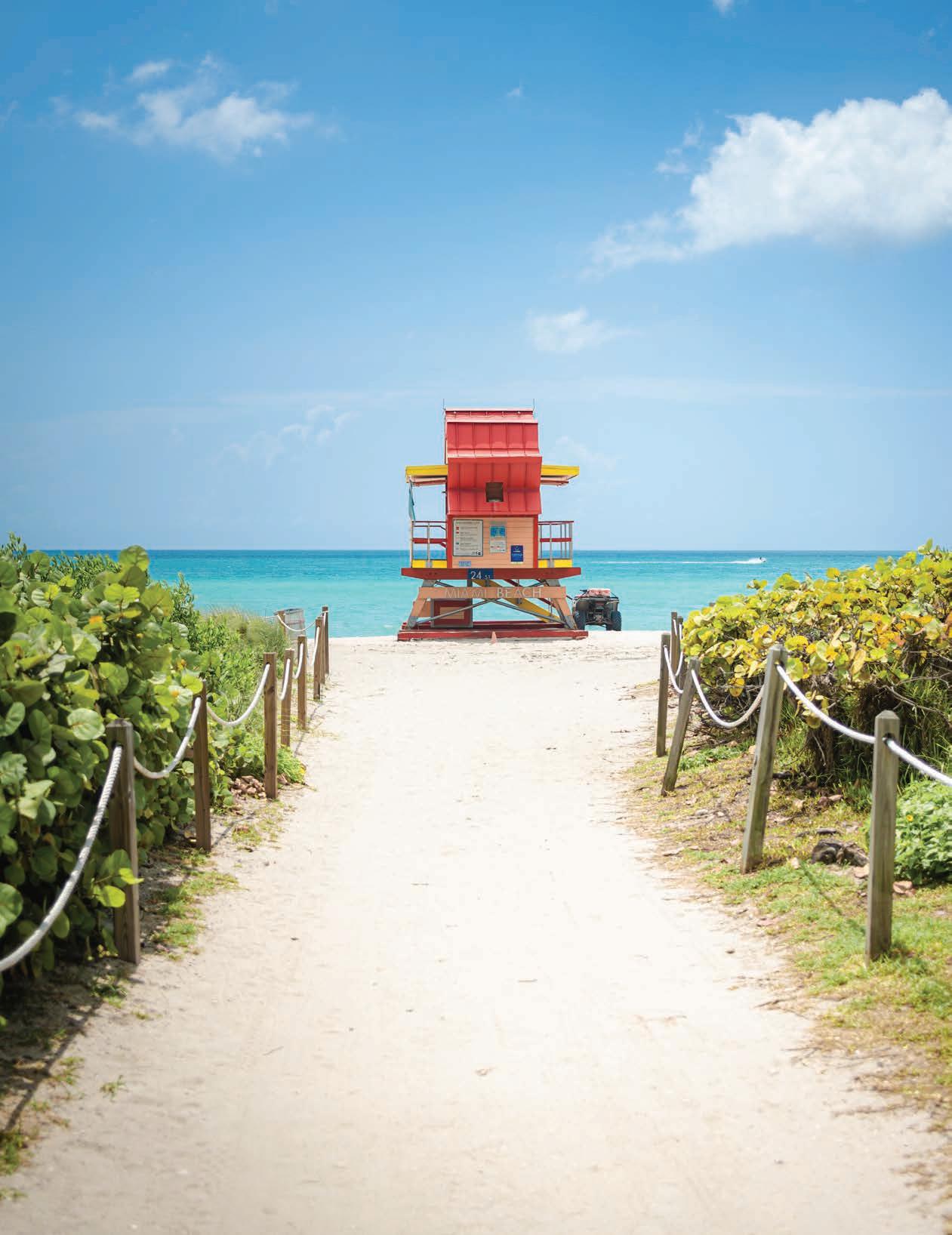





























































































































KEEP YOUR FAMILY SAFE AROUND WATER THIS SUMMER WITH THESE IMPORTANT TIPS BY MANDY HOWARD







Research the beach you’re going to and the meanings behind the warning flags. Proffitt realizes that, for most people, enjoying the beach and an ocean swim is not a daily opportunity. He understands the temptation to “just hop in” despite warning flags, which range from yellow (indicating moderate hazards) to red (indicating dangerous conditions).
“People may drive here from Raleigh because it’s a beautiful day, but they don’t check the swell, they don’t check the beach report,” he says. “They drive all the way down here, and [the water] ‘looks nice.’ They don’t want that drive to go to waste, so they get in the water … next thing you know they’re the ones we’re rescuing.”
Proffitt adds that they don’t change the warning flag colors lightly. “If we are flying a red flag, it is extremely dangerous. Do not get in the water.”
Understand rip currents. People get in trouble because they haven’t experienced a rip current, which is a powerful, narrow channel of fast-moving water. Proffitt explains, “Rip currents are not undertow, and they’re not some unicorn that’s going to pull you under. It’s only a channel of water that’s going out to sea. When it gets to deeper water, the intensity will dissipate.”
If you find yourself in the ocean and feel like you are being swept away from the beach, follow these tips:
• Do not panic.
• Stay afloat. Swim parallel to the beach and tread water, conserving energy.
• Do not try to fight the current and swim directly back to the beach.
• When the current lessens, swim at an angle away from the current, toward the shore.
Wear a life jacket. No matter how strong a swimmer you are, wear a life jacket—on a tube behind a boat, on a paddle board or in a kayak. On a boat, ensure you have a life jacket for every rider, and make sure kids wear theirs at all times. The United States Coast
Guard requires that children under 13 years of age to wear a Coast Guardapproved personal floatation device. Avoid a possible fine and keep your family safe.
Review boat safety. Depending on your boat and activities, go through the rules before you head out on the water. Remember to never swim near a boat while its motor is running. Cut the engine every time someone is swimming near a boat. Boaterkids.com offers boat safety advice and ways to childproof your boat.
No matter how strong a swimmer you are, wear a life jacket—on a tube behind a boat, on a paddle board or in a kayak.
the common rules at pools and mimic them at home, including:
• No running on pool decks
• No solo or unsupervised swimming
• Take scheduled, mandatory breaks (to reapply sunscreen and avoid exhaustion).
Drowning happens so often because it is eerily quiet. It has been described as someone trying to climb an invisible ladder. The head will be tilted back, eyes open, looking at the pool ledge, mouth at the water line. The arms and hands will be underwater while the feet pedal, as though trying to push down on a platform that is not there. The overall effect looks like someone calmly and silently bobbing up and down but not moving forward or backward. If you suspect you see this motion, do not hesitate. Go to that person immediately and assist them with a flotation device or get them to the edge of the pool. Be vigilant, always. Drowning is silent and fast. Keep your eyes on the water, even if you’re talking with friends.
Strengthen the swimming skills of your whole family. No one is ever too old for a lesson. Share the gift of swimming with your kids. If you’re a lake swimmer, consider an annual, beginning-of-summer challenge to see who can tread water the longest. While swimming skills do not guarantee safety, it is a vital proactive step.
More drownings happen in residential pools than in commercial pools because while adults may be present, they may not know what to look for. Consider these tips before swimming in any pool:
Listen to lifeguards. This tip is obviously for commercial pools, but it also extends to parents who may visit, or own, a residential pool. Understand
Learn CPR (cardiopulmonary resuscitation). Proffitt emphasizes, “Take CPR because whether it’s a drowning or a cardiac arrest event in your local parking lot, bystander CPR is what saves lives.” The American Red Cross, American Heart Association and other organizations offer training on this lifesaving skill.
Know your limitations. Whether it’s exhaustion, heat or possibly that beverage in your hand, know that even the strongest swimmers struggle if they are incapacitated for any reason.
Each year since Thomas’ death, I’ve offered to write an article on water safety or talk about it to groups of students. And yet, last summer I looked up to see my own kids paddle boarding deep on the lake without life jackets. I immediately called them in and righted the situation. But all drowning takes is just a moment. Through awareness, education and diligence, you can keep your family safe around all bodies of water. tf

North Carolina Railway Museum offers train lovers their best day ever


Do you have a train table at home? Is “choo choo” a go-to methodology for getting your toddler to eat their veggies? Do you want a fun, educational and unique experience that delights your whole family with lessons of history and technology?
If you said “yes” to any of these questions, a day of exploration at the North Carolina Railway Museum (NCRM) will be perfect for your choo-choo choosy family.
Located in New Hill, a short distance from Apex, the all-volunteer NCRM operates the New Hope Valley Railway which, in addition to interactive exhibits, offers an hour-long ride along 4 miles of historic railroad track behind a real locomotive. The railway has existed since 1905.
While the train ride is often the draw, the attraction offers so much more to visitors. Art Kotz, a volunteer and member of the NCRM Board of Directors, says he loves being able to share what he’s learned about railroading. “I find it fascinating how much the railroads have contributed to science and technology and how it influenced our country’s development and culture.”
Exhibits include a G-scale garden railway (Kotz notes that kids love the garden railway, especially when a certain friend named Thomas visits), a restored post office car and a caboose from the 1920s. NCRM is also renovating an actual depot, which was moved from Goldston, and a baggage car for indoor displays. Kotz notes that every visitor will walk away with a greater
understanding of both history and science. He says, “Come for the train ride, but also take the opportunity to learn a little history. You don’t [often] get to experience a real-life train ride or learn about the history and technology that goes behind the railways.”
NCRM’s website, triangletrain.com, offers a user-friendly, convenient way to plan your visit. Check out the schedule for excursions through December and purchase tickets online. Tickets range from $13–$17 with discounts for children and seniors. Children under the age of 2 are free.
Food and beverages are not sold at NCRM (except for special events), so visitors are welcome to take anything
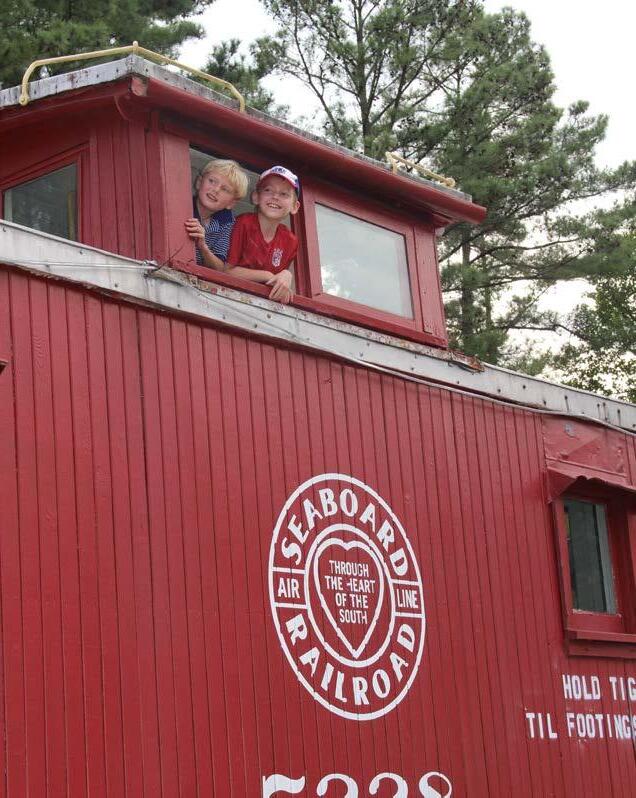


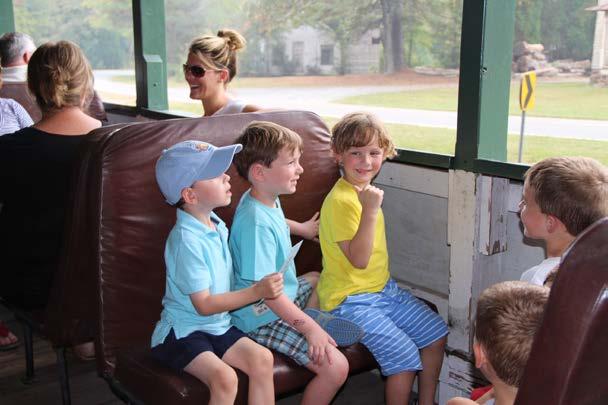

they need for the day and the ride. Picnic tables are provided, and it’s the perfect space to pack a lunch and enjoy a meal after a morning ride. Kotz recommends arriving at the museum at least 30 minutes prior to your departure time so you can check in and have a chance to explore the grounds.
NCRM is also a unique space for a birthday party. The stationary Birthday Party Caboose can be rented and decorated, and offers a memorable venue for kids of all ages.
While every train ride is memorable for families, New Hope Valley Railway offers special events that will fill your phone with photos you’ll be smiling at for years to come. Be sure to check out these unique opportunities. Tickets for all events are available at triangletrain.com.
• June 14 — Brew ‘n’ Choo Train Ride. Take a ride and enjoy a local brew from Thirsty Skull Brewery.
• Ongoing — Operate-a-Loco. Learn how to drive a locomotive. Operators must be 18 with a valid driver’s license.
• September 13-14 — Thomas & His Friends in the Garden. Little locomotives chug along the miniature garden railroad, pulling a variety of Thomas the Tank Engine-themed cars through the layout of tunnels, bridges, plants, trees, residential houses and an engine house.
• October 11, 18 and 25 — Track or Treat Halloween Express. See scenes of flying witches, smoking cauldrons, large pumpkin faces, Count Dracula and other friendly creatures along the tracks. Halloween costumes are encouraged.
• December 6–7, 13–14 and 20 — Santa’s Reindeer Roundup Express. Locate Santa’s missing reindeer in the woods. Santa will greet all of the guests on the train.
The Track or Treat Halloween Express and Santa’s Reindeer Roundup Express are eagerly awaited events that sell out every year. If you don’t want to miss that magic, look for tickets in July.
The North Carolina Railway Museum is located at 3900 Bonsal Road in New Hill. tf

We are financial planners, advisors, & confidants.
Where everyone has a seat at the table.

Triangle Family Where Lifestyle Meets Legacy
Reach influential families who value excellence, tradition and community. Advertise with Triangle Family to connect your brand with a discerning audience that leads, aspires and inspires.
Looking to join our community? Subscribe and explore the best in family life, luxury living, education and wellness—all curated just for the Triangle.
Trusted by Readers. Celebrated by Brands.


At Vesta, you’re not just another client; you’re an individual deserving the utmost respect and consideration. And as long as our doors are open, you’ll have a seat at the table. AT SANDHILLS CHILDREN’S CENTER, WE:

• Serve children with and without special developmental needs ages 6 weeks to 5 years old
• Have preschool teachers certified with NC Teacher licensure and all staff certified in CPR and First Aid
• Have class placements based on age
• Provide onsite therapies as needed (speech, physical, occupational…)
• Rely on fundraising and donations to support the unique and individual needs of our children


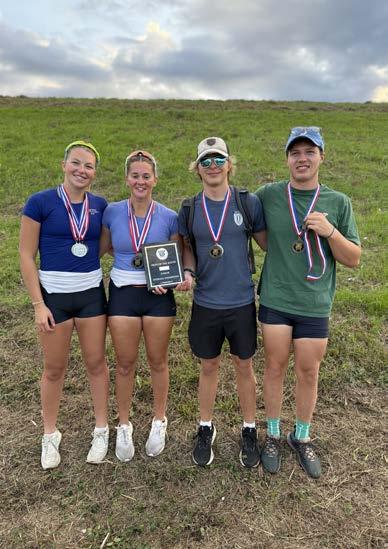



When Green Level High School senior James Barber was a freshman, he was still searching for a sport he could call his own. He played rec basketball and baseball as a kid, but nothing quite clicked. So when a friend convinced him to give rowing a try, he came in with an open mind.
“You’re outside, in the sun, on the water. It’s a good thing to hook you in,” Barber says. “When you’re rowing on the water with people in a boat, you have to be completely in time. You grow close bonds to the people you row with.”
Barber is among the 120 dedicated members of Triangle Rowing Club

(TRC), a competitive youth program for students from sixth to 12th grade. The club trains at Lake Wheeler Park in Raleigh nine months a year, offering spring and fall seasons.
“Most people come to our program with a preconception that they’re going to get into a canoe or kayak,” says Kees Koopman, varsity men’s head coach for TRC. “There’s a little bit of a mind-blown moment when they get into a boat that is 60-feet long and 200 pounds. Then they have to do this highly technical task in perfect synchronicity with seven other people.”
Jordan Lake Rowing Club (JLRC) in Apex offers similar opportunities, including both recreational and
competitive teams. Most of the rowing occurs in eight-person boats, where teamwork is a necessity. And like other sports, rowing provides a chance for young athletes to develop more than just athletic skills.
Emilie Gross is the head coach at JLRC. A former collegiate rower at Michigan State University, she is now on the coaching staff at Duke University. “My coaching philosophy, no matter what level of rowing I am coaching, is to utilize the sport of rowing to develop people beyond the sport,” she says. “My goal is to surround them with a strong work ethic and passion, and to mentor them in a safe environment, all while having fun.”



The local rowing clubs gain most of their members by word of mouth. For curious teens who want to check out the sport, the lack of experience is not a barrier to participation.
“There is no prior experience needed to join our team because it is so niche,” Koopman says. “We’re very experienced with taking kids who know nothing about rowing and turning them into, essentially, highperformance athletes.”
Ainsley Woodard is typical of most high school rowers. The Panther Creek High School senior ran track for two years before she suffered a knee injury that limited her participation. Her older sister was a rower, so Ainsley attended an event with JLRC. Two years later, she is a coxswain, the person who steers the boat and communicates with the crew.
“This is a really big part of my life,” Woodard says. “When I’m in rowing season, it takes up a lot of time. We practice five days a week, so I’m out at the lake a ton. But it doesn’t feel like it’s consuming me because I love it.”
The rowing clubs participate in competitions in the spring and fall. Spring events include time trials, where boats are seeded into lanes and race side-by-side on a 2,000-meter course. Fall regattas are mostly “head races,” where boats race from the opening of a river to the headwaters, usually 4–5 kilometers.

Both organizations offer weeklong learn-to-row camps from June–August. The programs run Monday–Friday in the morning. If rowers take a liking to the sport, they can join the rec program, which includes two or three practices per week and a couple of competitions each season.
Once rowers become more accomplished, they can earn their way onto varsity squads that train five days a week and participate in 8–10 competitions around North Carolina and the region.
“There’s a little bit of a mind-blown moment when they get into a boat that is 60-feet long and 200 pounds. Then they have to do this highly technical task in perfect synchronicity with seven other people.”
–Kees Koopman, Men’s Head Coach, Triangle Rowing Club
Josh Bower is another JLRC rower who came to the sport after years of searching for his athletic calling.
The Jordan High School junior spent eight years in taekwondo when a family friend encouraged him to try a learn-torow class. He’s been hooked for the past three years. “When you’re rowing, you’re engaging almost all of your muscles,” Bower says. “You’re pushing extremely hard. To be able to push through that and succeed, I haven’t been able to find that in any other sport. To be at a high level and succeed, you need to want it a lot. You need to work hard for it.”
The sport draws a relatively small number of teenage participants, but the opportunities extend beyond high school. Women’s rowing is an NCAAsanctioned sport, while men compete collegiately in a separate association. Many schools offer club rowing too.
“From our graduating classes, a lot of our athletes choose to remain in the sport in some way, shape or form,” Gross says. “Some enjoy a low-stress club atmosphere while others are actively looking to be recruited to row in college. The great thing about our sport is you can row well into your retired years.” tf
Learn more at trianglerowing.org and jordanlakerowingclub.org.


Here’s what local rowers say about their sport:
James Barber: “One of the biggest things is discipline. It’s a simple motion and a very repetitive one. To get to that high level, you have to do things that you’re not necessarily wanting to do in that moment. It’s a lot of discipline and I think it’s helped me a lot. I’ve applied it to my academic life and extracurriculars. I think the skills I’ve learned through discipline in rowing are really helpful.”
Josh Bower: “I feel like it requires a lot of competitiveness because the boats are right next to you when you’re in a race. You can see how close they are to you, how hard they’re working. The intimacy of the competition forces a good amount of competitiveness onto the rowers.”
Ainsley Woodard: “Being out on that water feels so different. Everything we do with daily tasks we’re on the land, but here you get to be on the water. It’s great. I love it. It’s also a great way to work out. It’s huge for your mental game. You learn so many things you apply in the real world that come in handy.”



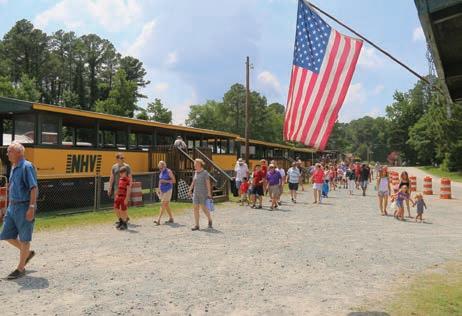



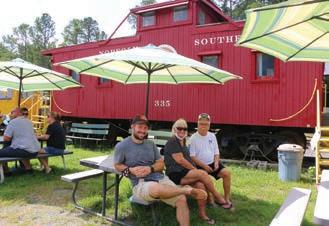






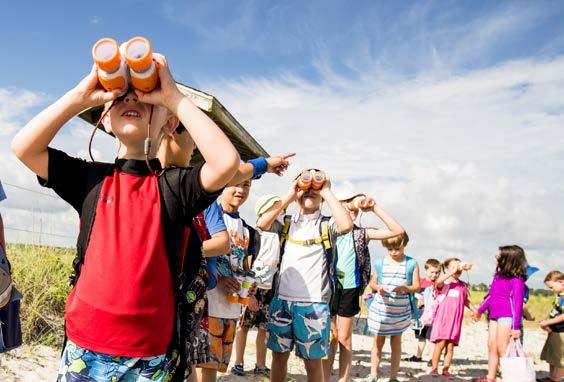



6–8
Excitement is building this spring as Gipson Play Plaza, located in Raleigh’s Dorothea Dix Park, celebrates its grand opening June 6–8 as the newest addition to the 308-acre park. The iconic attraction features interactive play areas, community spaces, a food and beverage market, and more.
partner, and help ensure the creation and long-term success of Dix Park,” according to the park’s website.
By Katherine Kopp
Dix Park, owned by the City of Raleigh, was formerly the site of Dorothea Dix Hospital, the state’s first mental hospital. The creation of Dix Park is an example of a best-practice, public-private partnership between the City of Raleigh and Dix Park Conservancy. The City of Raleigh owns and operates Dix Park. The Dix Park Conservancy is a 501(c)(3) nonprofit that exists to “support the city in its efforts, serve as its philanthropic
Many things will make the 18.5-acre Gipson Play Plaza special, says Kate Pearce, Dix Park executive director. “Opening the Gipson Play Plaza represents years of work with the community to bring a space to life that will inspire and delight people of all ages and backgrounds. I can’t wait for the community to experience it firsthand.”
Gipson Play Plaza is a cooperative endeavor among the City of Raleigh, Dix Park Conservancy and generous donors, including Raleigh residents Tom and Pat Gipson, for whom the play plaza is named.
The play plaza was originally referred to as the “Gateway” in Dix Park’s

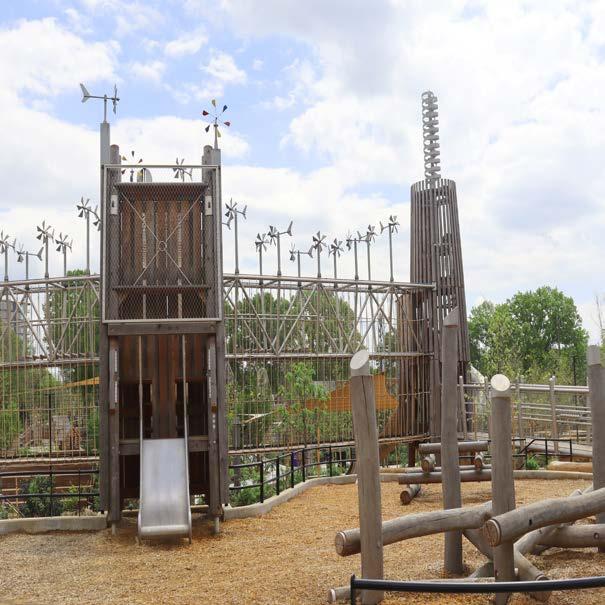
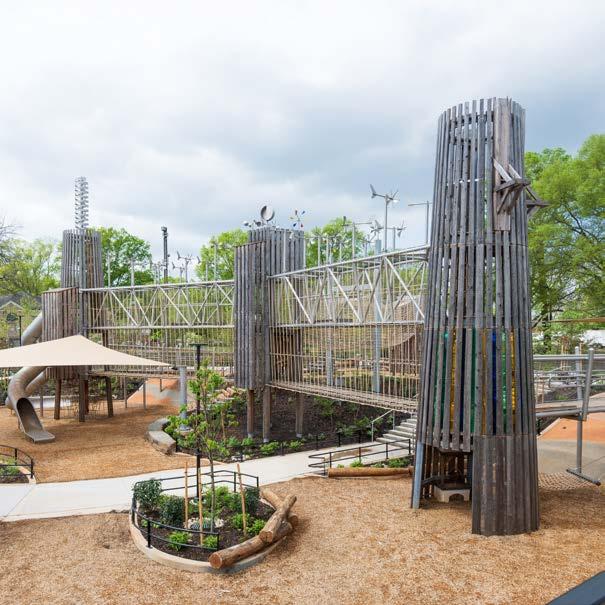
Thomas Gipson Homes in Raleigh. Over several decades, the company built more than 1,000 homes in Raleigh and Wake County. “We owe so much to the city of Raleigh that we wanted to give back,” says Tom.
master plan, says Pearce. “The concept was simple: that play welcomes everyone to the park. The location of the play plaza along Lake Wheeler Road creates a very visible entrance into Dix Park, giving an immediate sense of welcome and arrival,” she says. “Plus, it is easily accessed from both downtown Raleigh and I-40.”
The design team of Michael Van Valkenburgh Associates (MVVA) of New York and Richter Speilgerate of Frasdorf, Germany, partnered to create whimsical play structures for the plaza. “They were designed to delight the young and the young at heart,” Pearce says.
Tom and Pat Gipson were motivated to give back to their community after years of owning and operating
As they considered a commitment to making a play plaza a reality, the Gipsons visited other parks designed by MVVA. “They have done work at the Brooklyn Bridge Park and at the Gathering Place, a park in Tulsa, Oklahoma,” says Tom. “Pat and I visited there a few years ago, and it was amazing. National Geographic named the Gathering Place as #12 on its list of ‘mind-bending playgrounds around the world,’” he says. “Our play plaza will share many similar features with the Gathering Place.”
The Gipsons believe the play plaza will “really stir the imaginations of kids.” Some of its features include a 91-foot-long mega swing overlooking downtown Raleigh, accessible to visitors of all ages and abilities; Slide Valley, anchored by four custom play towers, connected by multilevel bridges and ranging from 15 to 46 feet in height; the Sand Bowl; and kid-powered water play at Watermill Mountain, inspired by Raleigh’s historic Yates Mill.
Acclaimed Raleigh sculptor Thomas Sayre has transformed two 73’ tall utility towers into a pair of sunflowers. The artworks of Mark Reigelman and Johnny Lee Chapman III will enhance the plaza’s environment and reflect its history. The House of Many Porches, one of many historic buildings within Dix Park, will offer gourmet graband-go items. A nearby picnic grove and swing terrace will provide the perfect spot to enjoy lunch while offering views of century-old oaks and the Raleigh skyline. The firm of Joseph K. Opperman–Architect, PA, is addressing the historical aspects of the master plan and its buildings.
The Gipsons are thrilled with the imaginative features of the play plaza. “Most parks are designed with so many constraints,” says Pat. “This park will let kids test their limits within a safe environment.”
Pearce says Gipson Play Plaza’s unique features will make it a “one-ofa-kind destination in the heart of North Carolina’s state capital.”
Dix Park Conservancy estimates that Gipson Play Plaza will draw more than 1 million visitors each year. Learn more about the attraction and its opening at dixpark.org/gipsonplayplaza. tf
By Dr. Robert Elliott, DMD, MS and Dr. Julie Molina, DDS, MS of Cary Pediatric Dentistry

In honor of National Dental Care Month in May, we put together some answers to the most common questions we get asked. It’s never too early to instill good dental habits in your child so they can enjoy healthy teeth and a beautiful smile that lasts for years.
How can I encourage good oral hygiene habits?
Start by making brushing and flossing a fun and regular part of their daily routine. A few ideas include using a kid-friendly toothbrush, downloading fun dental apps that encourage brushing and creating an oral hygiene routine at home. Praise your child when they brush well and take the opportunity to celebrate even the smallest of victories. Make sure your child has regular dentist appointments to monitor their oral health and help them become comfortable with dental visits. By making oral hygiene fun, consistent and part of your daily routine, you'll help your child develop good habits that will last a lifetime.
What dietary changes can I make to help prevent tooth decay?
We often discover the American diet is one of the main contributing factors to tooth decay. We recommend limiting sugary and acidic foods and drinks, maintaining a balanced diet and drinking plenty of water to prevent tooth decay. Parents often tell us their kids love to snack throughout the day. Tooth-friendly foods like raw vegetables (e.g., carrots, celery), nuts and fruits like apples that stimulate saliva production and help clean teeth are smart snack options. Gummy vitamins and snacks are also known culprits for decay. We advise using a liquid or chewable vitamin daily in place of gummies. Also, don't forget to practice good oral hygiene habits, like brushing twice a day with fluoride toothpaste and flossing nightly.
How safe are dental X-rays?
Dental X-rays are considered safe. The digital radiograph equipment used in dental offices today is light years away from that of past generations and the amount of external radiation scatter, as it’s known, from modern X-ray technology poses little to no threat to patients, according to the American Academy of Oral and Maxillofacial Radiology (AAOMR).
What are dental sealants and does my child need them?
Sealants are thin, protective coatings applied to the chewing surfaces of teeth, especially the back teeth (molars), to help prevent cavities. Sealants act as a barrier, shielding the enamel from bacteria and food particles that can lead to decay. They are particularly effective for children, as their back teeth have deep grooves that are harder to clean thoroughly with brushing alone. Most children can benefit from sealants once their permanent molars come in, usually around age six, and again when their second molars appear, around age 12. Your dentist can help determine if your child would benefit from sealants based on their oral health and needs.
What makes a pediatric dentist different?
A pediatric dentist is a dental specialist who treats children from infancy through adolescence, including those with special needs. Pediatric dentists complete additional training after dental school. They usually undergo a two- to three-year residency program, which includes in-depth education in child psychology, development and pediatric-specific dental treatments. A combination of specialized training, a kid-friendly environment and personalized care makes pediatric dentists the best choice for children’s dental health. tf

Dr. Robert Elliott, DMD, MS is board certified and a diplomate with The American Board of Pediatric Dentistry, as well as a fellow with The American Academy of Pediatric Dentistry. Dr. Julie Molina, DDS, MS is board certified and a diplomate with The American Board of Pediatric Dentistry. Dr. Elliott and Dr. Molina partnered to form Cary Pediatric Dentistry in 2008.

Saturdays in May and June, 10:30 a.m.–12:30 p.m.; tour not offered May 31
Tour begins at 150 E. King Street, Hillsborough
Experience American history through the unique perspective of one of North Carolina’s oldest towns on a guided walking tour. View historic places from 1790 to 1840, including the grave of one of North Carolina’s signers of the Declaration of Independence. Purchase tickets online, which are $10 for adults and free for ages 10 and younger. historichillsborough.org/events

May 11, 11 a.m.–2 p.m.
Downtown Cary Park 327 S. Academy Street, Cary
Celebrate Mother’s Day with live music from the North Carolina Chamber Music Institute, free chair massages, creative crafts at the Art Cart and tasty bites from a local food truck. downtowncarypark.com
May 15–18
Raleigh Memorial Auditorium 2 E. South Street, Raleigh Carolina Ballet’s production highlights the tragic romance of Prince Siegfried and the swan princess Odette. carolinaballet.com
BY JANICE L EWINE I MAY + JUNE 2025

May 17, 10:30 a.m.–2 p.m.
The Factory
1839 S. Main Street, Wake Forest
Get in the driver’s seat of vehicles that assist the community by exploring police cars, fire trucks, a helicopter, military vehicles and more. Admission is $5 per person or $20 per family. Proceeds benefit the Law Enforcement Torch Run for Special Olympics NC. sonc.net/events


May 17, 1–7 p.m.
Rock Quarry Park 701 Stadium Drive, Durham
Live music, traditional cuisine and local talent highlight this annual celebration of African and African American culture. dprplaymore.org
May 17–18
City Plaza, downtown Raleigh
Artsplosure is one of the longest-running arts festivals in North Carolina. Shop more than 175 juried visual artists showcasing works in ceramics, glass, jewelry, painting, photography and more. Enjoy national and regional entertainment on two stages, arts-based activities for children and temporary art installations. artsplosure.org
May 20–25
Durham Performing Arts Center
123 Vivian Street, Durham
When Marty McFly finds himself transported back to 1955 in a time machine built by the eccentric scientist Doc Brown, he accidentally changes the course of history. He’s in a race against time to fix the present, escape the past and send himself back to the future. This musical is adapted for the stage by the iconic film’s creators Bob Gale and Robert Zemeckis. dpacnc.com
June 6–29
Raleigh Little Theatre
301 Pogue Street, Raleigh
This musical adaptation of Alice Walker’s Pulitzer Prize-winning novel spotlights Celie, a downtrodden young woman whose personal awakening over the course of 40 years forms the arc of this epic story. With a joyous score featuring jazz, ragtime, blues, gospel and African music, “The Color Purple” is a testament to the healing power of love and a celebration of life. raleighlittletheatre.org

“BLUE
June 21–January 11
North Carolina Museum of Natural Sciences, 11 W. Jones Street, Raleigh Dive into the details behind the mind-blowing biology of blue whales and learn how they became the planet’s biggest mammals. Purchase tickets online. naturalsciences.org
June 7, 11 a.m.–9 p.m.
City Plaza, downtown Raleigh Take a trip around the world without leaving the Triangle. More than 100 food trucks representing 60 countries flaunt their cuisine along Fayetteville Street in this lively event that also features music and dancing. ncvibes.com/raleighsinternational-food-festival
June 19, 4–8 p.m.
Carrboro Town Commons
301 W. Main Street, Carrboro Juneteenth, also known as Emancipation Day, commemorates the emancipation of enslaved people in the United States. Take the family for food, music, activities and more in this uplifting community event. chapelhillarts.org

June 28–29
Raleigh Convention Center
500 S. Salisbury Street, Raleigh Marvel at amazing works of art built with Lego bricks, meet professional artists and gain insights into their building techniques. Shop Lego vendors and unleash your creativity in building zones. Purchase tickets online for timed admission slots. brickuniverseusa.com
Be sure to check the websites for these events before you head out to ensure they are still taking place.
Noodle kugel is a traditional dish dating back to the 1500s. This version adds a sweet touch by incorporating fruit and has been treasured by the Marcus family of Apex for over 75 years.
16 ounces egg noodles
6 large eggs
1 ½ teaspoon vanilla
½ cup (1 stick) margarine, softened
Scant ¼ cup sugar
2 ½ tablespoons cinnamon
2 pinches salt
8-ounce can pineapple, crushed or tidbits, drained
(2) 1-ounce box of raisins (can use a mixture of raisins and dried cranberries)
1 small apple or orange, peeled and cut into small pieces
Nonstick cooking spray

1. Preheat oven to 325° F.
2. Boil the egg noodles until tender yet firm to the bite, 8 to 9 minutes. Drain. Return the noodles to the pot.
3. In a large bowl, lightly mix the eggs and vanilla together. Add the noodles and stir.
4. Add the softened margarine to the noodle mix and stir.
5. Add the sugar, cinnamon, salt, pineapple, raisins and apple (or orange) to the noodle mix and stir.
6. Coat a 13x9-inch baking pan with nonstick cooking spray.
7. Pour the noodle mix into the prepared baking dish.
8. Bake uncovered, until golden brown on top, about 40 minutes. Remove from oven and let cool slightly before cutting into portions. Serve warm.
BY KURT DUSTERBERG

Enloe football lineman Chandler Telfaire is ready to tackle a challenge at the University of Delaware
Chandler Telfaire stands out in a crowd. At 6-feet-4 and 245 pounds, the Enloe Magnet High School senior rarely goes unnoticed. But for the young men who play a certain football position, there is the paradoxical fate of somehow never being fully seen.
“If you watch an NFL game, nobody understands or notices the offensive line,” Telfaire says. “They’re always doing the dirty work. You just notice, ‘oh, that’s a good run.’ There’s a lot that goes into it.”
The 17-year-old has made a name for himself as a high school player, anchoring the Eagles’ offensive line as a left tackle. He has, in fact, been seen for his blocking skills, earning a football scholarship at the University of Delaware. The Fightin’ Blue Hens were one of nearly a dozen schools who offered a scholarship. His short list also included North Carolina Central University and the University of West Georgia.
In the fall, Delaware will move up to the Football Bowl Subdivision, the top tier of college athletics, and play in Conference USA. The challenge is appealing to Telfaire, but so is the opportunity to set out on his own. “I’ve always wanted to learn and grow more away from home without the guidance of my parents, build new relationships and connections,” he says.
Telfaire began playing football at age 6, and by the time he was playing Pop Warner football at age 9, he was a wide receiver and running back. But soon his coaches couldn’t ignore his sturdy frame, making him a clear choice for the offensive line. He played JV ball as a ninth grader before earning a few games on varsity late in the season.
“It was around my sophomore year when I was like, I think I can pursue it at the college level at this position,” Telfaire says. “I started gaining a little bit of weight and working hard in the weight room, trying to get bigger, stronger and faster. That’s when I kind of flipped the switch.”
At left tackle, he has the critical responsibility of protecting the quarterback’s blind side. “It’s a great honor, knowing how special and hard the position is,” he says. “I’m left-handed, so it kind of works out with my body. That’s my stronger hand, so it helps me with my strike.”
Few people understand the challenge of blocking with an offensive line. The job requires strength, stamina and agility. A lineman’s goal is to win the physical battle on every play.


“People don’t really understand how mental it can be,” Telfaire explains. “If you look at the guy across from you and think, ‘Oh, he’s pretty big’ … you can’t go in with that mindset. And of course, physicality comes with that. To develop your footwork is the key thing for offensive linemen. The defensive linemen are becoming more and more athletic.”
Telfaire earned all-conference honors all three years as a varsity starter and was Enloe’s MVP as a senior. Away from the football field, he pours his energy into a variety of pursuits. He recently earned his Eagle Scout badge and is active in Jack and Jill of America, a community service organization. He is one of Darius and Courtney Telfaire’s four children—and a triplet.
“My wife and I stress to all our children that it’s student first, then athlete second,” Darius says. “You can do all these extracurricular activities, but we want to make sure you get your studies done first.”
To that end, Telfaire will study sports management in college. On the field, he hopes to crack the starting lineup as a sophomore and eventually be an all-conference selection. “The coaching staff was very personable,” he says. “They wanted me, and I just felt at home at Delaware. It was a great atmosphere to be around.” tf
•Targeted
•Behavior-Based
•Custom
•Multi-Channel




River is 9 months old and loves to play. He and Dad spend every morning playing fetch. He loves his family and wants to be included in EVERYthing! He’s really smart and is learning his commands. Sometimes he gets excited and needs loving instruction, but we’re really proud of him. Late at night, he loves to snuggle and watch sports with the family.
—Sherry and Kent, Cary













“He who would understand the nature of true holiness must know that the Christian is a ‘man of war.’ If we would be holy, we must fight!” JC Ryle, 1877
All male, 6th–12th. Focused. Joyful. Effective. Highly selective. We are a mission-led community that is willing to fight for Biblical manhood!
•Fight to be God-honoring men
•Fight to be gentlemen who love well
•Fight to be deep thinkers
•Fight to be exceptional leaders
• Fight to be strong husbands and forever fathers
•Fight to be extraordinary citizens
To join the fight, scan the QR code below:
